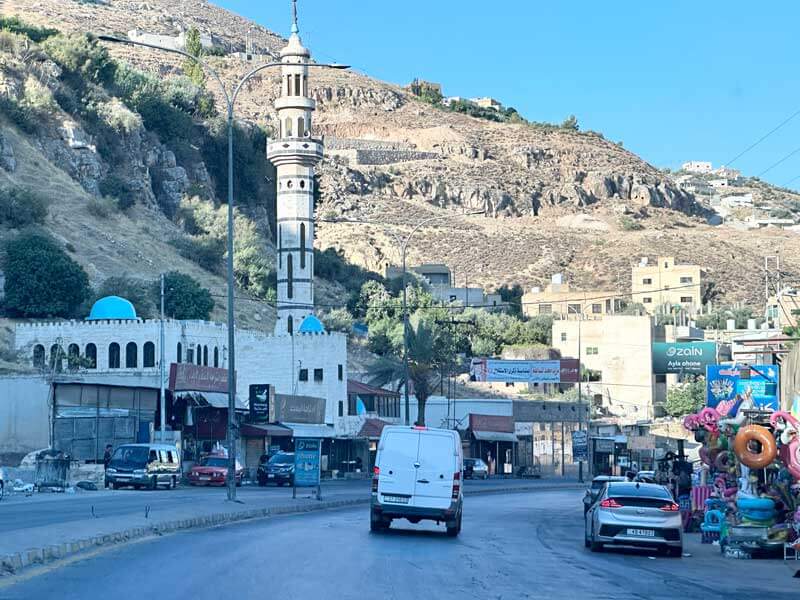Please know that traveling from Amman, Jordan to Jerusalem, Israel on your own is not for the faint of heart. Compared to other countries in the region, Israel and Jordan are not mortal enemies, but the King Hussein Bridge crossing, also known as Allenby Bridge, is still a tense border crossing. Give yourself at least five hours to make the crossing each way. Also be sure to carry at least a few hundred Israeli Shekels (NIS) and Jordanian Dinars (JOD) with you.
I will describe my experience crossing the border in early August of 2024, shortly after Israel assassinated a Hamas leader in Tehran. Many flights were cancelled to and from Tel Aviv, and the border was devoid of tourists. As a result, your experience may be different, but hopefully this post will give you an idea of what to expect at the King Hussein Bridge and Israeli-Jordan border. Also, you should note that I hold an American passport. Holders of other passports may find this to be a different experience.
How to get to the King Hussein Bridge border crossing from Amman
Getting to the King Hussein border crossing from our hotel in downtown Jordan was relatively simple. We booked an Uber the night before, and we were picked up at 7:15AM. The price we agreed to on the app was 20 JOD (about 28 USD). The drive down to the border was quite pleasant, and we had a beautiful view of the Dead Sea off to our left as we descended towards the crossing. On the way, our Uber driver called “911” and talked to the local police. A few minutes later, he informed us that he was not permitted to take us all the way to the border. He would have to drop us off nearby and a local yellow cab, driven by one of his friends, would take us the rest of the way. We paid this local taxi driver 3 JOD (about 4.20 USD) for the short ride to the border area. To avoid this situation, I would suggest finding a local taxi in Amman which has the permit can take you all the way to the border.

How to leave Jordan to go to Jerusalem
Our taxi driver pulled up in front of a large gate and we disembarked. We walked through the gate and towards the “arrival” building. As it turns out, this building is used for exiting and entering Jordan. Unfortunately, there was a large NGO group in front of us, and we had to wait for more than 30 minutes just to get up to the conveyor belt where we had to place our bags for inspection. Looking back though, this was most likely a short wait as there were almost no tourists going in with us.
We were going to Jerusalem for just one night, so we only had small backpacks with us. We passed through security with relative ease. Those with larger bags were subject to more thorough inspections. Once we entered the immigration area, we were instructed to approach a window on the far right, where we handed over our passports for inspection. Our passports were stamped and handed back to us. I had heard that we would have to pay an exit fee, but we were never asked for money. Next, we had to take our passports and approach another window on the left. An official took our passports from us and asked if we wanted the “regular” service or the VIP service. The cost of the VIP service would be 100 JOD (about 140 USD per person) while the cost of the regular service would only be 6 JOD (around 8.50 USD). Looking back, we probably should have gone for the VIP service, but we didn’t know any better at the time.
And then the long wait began. As I learned later, the normal shuttles which traverse the border don’t leave until a certain number of people have boarded. We don’t know exactly how people this is, and the bus we took was not full, but the wait was long! The officials kept telling us to wait for a few more minutes, but more than an hour passed before our passports were returned and we were ushered to the bus. If we had chosen the more expensive “VIP” option, we would have boarded a smaller “JETT” shuttle which would have taken us to the Israeli side much faster.
Once we boarded the bus, the driver collected 6 JOD from us, and another 15 minutes passed before the bus finally took off. The trip itself across “no man’s” land lasted about 10-15 minutes and our progress slowed considerably as we approached the Israeli side. Our bus was subjected to an external bomb search and at one point, IDF soldiers boarded our vehicle to have a quick look around.
Passing through Israeli Border Control
Once we reached the immigration building, we had to pass through several checkpoints but thanks to the small bags we were carrying, this process was a little faster than others. A shorter line was available for people who were just carrying hand luggage. This was just an initial passport check. Next, we waited in a longer line to pass through a security check which reminded me of airport security. Laptops came out, belts came off, and our bags went into plastic boxes. These boxes went through an Xray machine. On the other side of this security check our passports were examined once again, and this time our photos were taken. We were then issued small permits containing our photos, names, and passport photos. Israel no longer stamps passports, so it is important to hang on to these permits, as they provide physical proof of your legal entry into the country. Once again, we were not asked to pay any money.

Traveling to Jerusalem from the Israeli Border at the King Hussein Bridge Crossing
By the time we exited the immigration building, it was around 11:15AM. Four hours had passed since we had left our hotel in Amman. Because we were in a hurry, we elected to take a taxi to Jerusalem. There was a small booth right outside the immigration exit. We were told the fee to Jerusalem was 350 NIS (about 94 USD). I attempted to bargain a bit, but I was told the price was fixed. Looking back, I remember seeing some other taxis in the parking lot, and I probably could have tried harder to find a better deal. If you have plenty of time, there are also shuttles to Jerusalem and Tel Aviv which are much cheaper.
An hour later, we were dropped off at a restaurant in West Jerusalem, where we were meeting a friend. It took us five hours to travel the 98 kilometers from Amman to Jerusalem. We were relieved to have made it to Jerusalem, but I was not looking forward to going through this process again the next day.
Traveling from Jerusalem to Amman via the King Hussein Bridge
The next afternoon, we walked to the Damascus Gate to find a taxi to take us back to the Hussein Bridge border crossing. The lowest price I could find was 250 NIS (about 67 USD), but quite frankly, I was put off by the aggressive attitudes of the taxi drivers. They surrounded me and tried to pressure me to let them take me to the border. I finally walked away and decided to use the Gett Taxi app to call a taxi. I figured it might be more expensive going by meter, but I felt safer doing it this way.
As it turns out, taking a taxi by meter to the border cost us exactly 249 NIS (about 67 USD). I think the price could have even been cheaper on a different day, but we had to wait a long time at the border before we were allowed to pass through to the Israeli immigration building. When we arrived at the border, the meter was somewhere around 220 NIS (about 60 USD), but because of the long rate, the number rose by almost 30 NIS.

As American citizens, we were able to scan our passports on one of two machines up against the wall on the left side within the immigration building. Next, we had to wait in line to pay an exit fee of 200 NIS (about 54 USD) per person. I paid with a credit card. Given the fact that my tax dollars go to fund many billions of dollars’ worth of assistance to Israel, I was disappointed we had to pay this fee. After passing through two more checkpoints, we were asked to pay 13 NIS per person for the return shuttle ride to the Jordanian side of the border. Once again, the wait seemed interminable. We must have waited for at least an hour before we were finally ushered onto the shuttle. Yet we sat there for another 15 minutes because the shuttle driver discovered that there were some Palestinians on board. We learned that these shuttle buses are segregated. Foreigners travel on one bus and Palestinians travel on their own buses. Once they disembarked from the bus, we finally took off for the border.
Once back on the Jordanian side, we entered through the same building. We were handed a card with Arabic instructions, and I was asked to write down both of our names and birthdates. I had expected that we would have to pay for visas again but to my pleasant surprise, we were allowed to re-enter Jordan for free. Getting from the Damascus Gate in Jerusalem back into Amman had taken us another four hours or so.
Traveling to Christ’s Baptism site in Jordan from the King Hussein Bridge

I tried to call an Uber to take us to the site of Christ’s baptism (Bethany beyond the Jordan) which is nearby, but no rides were available. I bargained a local taxi driver down from 30 JOD (42 USD) to 13 JOD (18 USD) to take us to the site, which was probably still too much. The trip to the baptism site took about 15 minutes.
Is traveling to overland from Jordan to Israel safe?
While it is true that you will find yourself in the West Bank as soon as you pass through Israeli immigration, the roads that lead to Jerusalem (Route 1 and then Route 90) are relatively safe. If you are not veering off these roads into Jericho, for example, or into one of the West Bank settlements, you should be fine. However, it is always a good idea to keep an eye on the news before you cross over, as unrest can pop up at any time.
You should also remember that anytime you are crossing into another country, you are at the mercy of the officials on either side. They have completely power over you, and if they decide they don’t like you, or that you are a suspicious person, you may be detained for a long while. Be prepared for these delays and always be polite and tell the truth!
When does the Israeli – Jordan border at the King Hussein Bridge open and close?
According to what we were told, the Israeli-Jordan border opens at 8AM and closes at 4:30PM on either side. However, technically the border closes around 5PM to give the last group of people crossing time to make it to the other side. My suggestion is to make sure you show up at the border well before 4:30PM on either side.
Conclusion
Crossing a border into another country is a privilege, not a right. It is important to maintain your cool and be polite no matter what happens. The process of crossing from Jordan into Israel or vice versa can be frustrating at times, but you have little control. Just make sure you give yourself plenty of time, bring a good book to read, and most importantly relax and enjoy the experience! You will see that some have described the crossing over this border as “hellish”, but I did not find this to be the case. However, this may be due to the fact that I hold an American passport. Other nationalities may find this experience to be very different. I highly recommend taking advantage of one of the VIP services available for a faster and smoother process.
Check out our collection of beautiful Olive Wood Gifts from Buy Religious.


